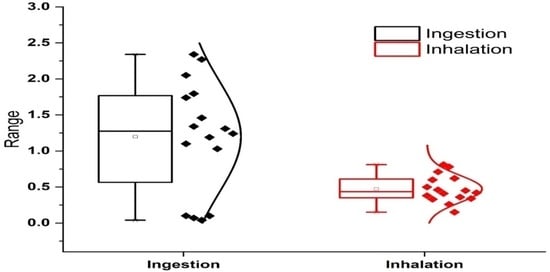Measurement of Radon Concentration in Water within Ojo Axis of Lagos State, Nigeria
Abstract
:1. Introduction
2. Materials and Methods
Radon Measurement
3. Results
4. Conclusions
Author Contributions
Funding
Institutional Review Board Statement
Informed Consent Statement
Data Availability Statement
Conflicts of Interest
References
- Ganiyu, S.A.; Olurin, O.T.; Azeez, M.A.; Jegede, O.A.; Okeh, A.; Kuforiji, H.I. Evaluation of major anions, halide ions, nitrogen, and phosphorus contents in groundwater from shallow hand-dug wells near Ona River, Ibadan, Nigeria. Int. J. Environ. Sci. Technol. 2022, 19, 4997–5014. [Google Scholar] [CrossRef]
- De Groot, R.S.; Wilson, M.A.; Boumans, R.M.J. A typology for the classification, description and valuation of ecosystem functions, goods and services. Ecol. Econ. 2002, 41, 393–408. [Google Scholar] [CrossRef]
- Ogunkunle, T.J.; Adewumi, A.; Adepoju, A.O. Biodiversity: Overexploited but underutilized natural resource for human existence and economic development. Environ. Ecosyst. Sci. 2019, 3, 26–34. [Google Scholar] [CrossRef]
- Geissen, V.; Mol, H.; Klumpp, E.; Umlauf, G.; Nadal, M.; Van der Ploeg, M.; Van de Zee, S.E.; Ritsema, C.J. Emerging pollutants in the environment: A challenge for water resource management. Int. Soil Water Conserv. Res. 2015, 3, 57–65. [Google Scholar] [CrossRef]
- Clarke, R.; Healy, M.G.; Fenton, O.; Cummins, E. A quantitative risk ranking model to evaluate emerging organic contaminants in biosolid amended land and potential transport to drinking water. Hum. Ecol. Risk Assess. Int. J. 2016, 22, 958–990. [Google Scholar] [CrossRef]
- Egboka, B.C.; Nwankwor, G.I.; Orajaka, I.P.; Ejiofor, A.O. Principles and problems of environmental pollution of groundwater resources with case examples from developing countries. Environ. Health Perspect. 1989, 83, 39–68. [Google Scholar] [CrossRef]
- Gavrilescu, M.; Pavel, L.V.; Cretescu, I. Characterization and remediation of soils contaminated with uranium. J. Hazard. Mater. 2009, 163, 475–510. [Google Scholar]
- Ravikumar, P.; Somashekar, R.K. Natural 3H radioactivity analyses in groundwater and estimation of committed effective dose due to groundwater ingestion in Varahi and Markandeya river basins, Karnataka State, India. J. Radioanal. Nucl. Chem. 2011, 288, 271–278. [Google Scholar] [CrossRef]
- Rangaswamy, D.R.; Srinivasa, E.; Srilatha, M.C.; Sannappa, J. Measurement of radon concentration in drinking water of Shimoga district, Karnataka, India. J. Radioanal. Nucl. Chem. Artic. 2016, 307, 907–916. [Google Scholar] [CrossRef]
- Srinivasa, E.; Rangaswamy, D.R.; Sannappa, J. Determination of radon activity concentration in drinking water and evaluation of the annual effective dose in Hassan district, Karnataka state, India. J. Radioanal. Nucl. Chem. Artic. 2015, 305, 665–673. [Google Scholar] [CrossRef]
- Harrell, J.A.; Belsito, M.E.; Kumar, A. Radon hazards associated with outcrops of Ohio Shale in Ohio. Environ. Earth Sci. 1991, 18, 17–26. [Google Scholar] [CrossRef]
- Taat, S.; Eko, H. Hydrochemical and environmental isotopes analysis for characterizing a complex karst hydrogeological system of Watuputih area, Rembang, Central Java, Indonesia. Hydrogeol. J. 2020, 28, 1635–1659. [Google Scholar]
- Auvinen, A.; Kurttio, P.; Pekkanen, J.; Pukkala, E.; Ilus, T.; Salonen, L. Uranium and other natural radionuclides in drinking water and risk of leukemia: A case-cohort study in Finland. Cancer Causes Control. 2002, 13, 825–829. [Google Scholar] [CrossRef] [PubMed]
- Madzunya, D.; Dudu, V.; Mathuthu, M.; Manjoro, M. Radiological health risk assessment of drinking water and soil dust from Gauteng and North West Provinces, in South Africa. Heliyon 2020, 6, e03392. [Google Scholar] [CrossRef]
- Chmielewska, I.; Chałupnik, S.; Wysocka, M.; Smoliński, A. Radium measurements in bottled natural mineral-, spring- and medicinal waters from Poland. Water Resour. Ind. 2020, 24, 100133. [Google Scholar] [CrossRef]
- Pourimani, R.; Nemati, Z. Measurement of Radionuclide Concentration in Some Water Resources in Markazi Province, Iran. Iran. J. Med. Phys. 2016, 13, 49–57. [Google Scholar] [CrossRef]
- Parhoudeh, M.; Khoshgard, K.; Zare, M.R.; Ebrahiminia, A. Measurement of the natural radioactivity level of 226Ra, 232Th and 40K radionuclides in drinking water of residential areas in Kermanshah province (Iran) using gamma spectroscopy. Iran. J. Med. Phys. 2019, 16, 98–102. [Google Scholar] [CrossRef]
- Badhan, K.; Mehra, R.; Sonkawade, R.G. Measurement of radon concentration in ground water using RAD7 and assessment of average annual dose in the environs of NITJ, Punjab, India. India J. Pure Appl. Phys. 2010, 48, 508–511. [Google Scholar]
- Kumar, A.; Kaur, M.; Sharma, S.; Mehra, R. A study of radon concentration in drinking water samples of Amritsar city of Punjab (India). Radiat. Prot. Environ. 2016, 39, 13. [Google Scholar] [CrossRef]
- Binesh, A.; Arabshahi, H.; Pourhabib, Z. Radioactivity and dose assessment of heavy radioactive pollution, radon and radium from water sources of 3 northern regions in Iran. Int. J. Phys. Sci. 2011, 6, 7969–7977. [Google Scholar] [CrossRef]
- Tawfiq, N.F.; Rasheed, N.O.; Aziz, A.A. Measurement of indoor radon concentration in various dwellings of Baghdad Iraq. Int. J. Phys. 2015, 3, 202–207. [Google Scholar]
- Ravikumar, P.; Somashekar, R.K. Distribution of 222Rn in groundwater and estimation of resulting radiation dose to different age groups: A case study from Bangalore City. Hum. Ecol. Risk Assess. Int. J. 2018, 24, 174–185. [Google Scholar] [CrossRef]
- Asimakou, K.; Kallithrakas-Kontos, N.; Vafeidis, A.; Manoutsoglou, E. Distribution of Radon Concentrations in Active and Inactive Underground Mines: A Literature Review. Mater. Proc. 2021, 5, 38. [Google Scholar] [CrossRef]
- Singh, P.; Singh, P.; Singh, S.; Sahoo, B.; Sapra, B.; Bajwa, B. A study of indoor radon, thoron and their progeny measurement in Tosham region Haryana, India. J. Radiat. Res. Appl. Sci. 2015, 8, 226–233. [Google Scholar] [CrossRef] [Green Version]
- Balasubramaniam, M.; Pawade, A.; Charhate, D. A Prognosis of the Cause and Effects of Radon on the Built Environment. In Proceedings of the International Conference on Recent Advances in Computational Techniques (IC-RACT), Online, 26–27 June 2020. [Google Scholar]
- Sanjon, E.P.; Maier, A.; Hinrichs, A.; Kraft, G.; Drossel, B.; Fournier, C. A combined experimental and theoretical study of radon solubility in fat and water. Sci. Rep. 2019, 9, 10768. [Google Scholar] [CrossRef]
- Kasić, A.; Kasumović, A.; Adrović, F.; Hodžić, M. Radon measurements in well and spring water of the Tuzla area, Bosnia and Herzegovina. Arch. Ind. Hyg. Toxicol. 2016, 67, 332–339. [Google Scholar] [CrossRef] [PubMed]
- Jobbágy, V.; Altzitzoglou, T.; Malo, P.; Tanner, V.; Hult, M. A brief overview on radon measurements in drinking water. J. Environ. Radioact. 2017, 173, 18–24. [Google Scholar] [CrossRef]
- USEPA. Radon in Drinking Water Health Risk Reduction and Cost Analysis; Federal Register: Washington, DC, USA, 1999.
- Fakhri, Y.; Kargosha, M.; Langarizadeh, G.; Zandsalimi, Y.; Amirhajeloo, L.R.; Moradi, M.; Moradi, B.; Mirzaei, M. Effective Dose Radon 222 of the Tap Water in Children and Adults People; Minab City, Iran. Glob. J. Health Sci. 2016, 8, 234–243. [Google Scholar] [CrossRef]
- Amin, R.M. Evaluation of radon gas concentration in the drinking water and dwellings of south west Libya, using CR-39 detectors. Int. J. Environ. Sci. 2013, 4, 484–490. [Google Scholar] [CrossRef]
- Al-harahsheh, S.; Al-dalabeeh, M. Measurement of Radon Levels in the Groundwater of Al-Rusaifah City in Zarqa Governorate Using Liquid Scintillation Counter. Jordan J. Earth Environ. Sci. 2020, 11, 98–102. [Google Scholar] [CrossRef]
- Jasaitis, D.; Pečiulienė, M. Natural Radioactivity and Radon Exhalation from Building Materials in Underground Parking Lots. Appl. Sci. 2021, 11, 7475. [Google Scholar] [CrossRef]
- Gogoi, P.P.; Barooah, D. Assessment of radon exhalation rates, effective radium content and radiological exposure dose, of coal and rocks in Tiru Valley Coal Field, India using track etched technique. Phys. Scr. 2022, 97, 085005. [Google Scholar] [CrossRef]
- El-Araby, E.H.; Soliman, H.A.; Abo-Elmagd, M. Measurement of radon levels in water and the associated health hazards in Jazan, Saudi Arabia. J. Radiat. Res. Appl. Sci. 2019, 12, 31–36. [Google Scholar] [CrossRef]
- Hopke, P.; Borak, T.B.; Doull, J.; Cleaver, J.E.; Eckerman, K.F.; Gundersen, L.C.S.; Harley, N.H.; Hess, C.T.; Kinner, N.E.; Kopecky, K.J.; et al. Health Risks Due to Radon in Drinking Water. Environ. Sci. Technol. 2000, 34, 921–926. [Google Scholar] [CrossRef] [Green Version]
- Grasty, R.L.; Lamarre, J.R. The annual effective dose from natural sources of ionising radiation in Canada. Radiat. Prot. Dosim. 2004, 108, 215–226. [Google Scholar] [CrossRef]
- Naskar, A.K.; Gazi, M.; Mondal, M.; Deb, A. Water radon risk in Susunia hill area: An assessment in terms of radiation dose. Environ. Sci. Pollut. Res. 2022, 29, 11160–11171. [Google Scholar] [CrossRef]
- European Union Commission. Recommendation on the protection of the public against exposure to radon in drinking water supplies. Off. J. Eur. Community 2001, OJ L 344, 85–88. [Google Scholar]
- Khaled, S.D.; Khaled, A.M.; Shaban, R.H.; Baset, A.A. Measurement of 222Rn concentration levels in drinking water samples from Qena city (Egypt) and evaluation of the annual effective doses. Int. J. Radiat. Res. 2020, 18, 227–233. [Google Scholar] [CrossRef]
- Mohamed, A.; Mahdy, H.T. Indoor Radon Concentration in Some Villages of Al-Lieth Province in Saudi Arabia for Applied Science Indoor Radon Concentration in Some Villages of Al-Lieth Province in Saudi Arabia. J. Umm Al-Qura Univ. Appl. Sci. 2020, 6, 48–50. [Google Scholar]
- Isinkaye, M.O.; Matthew-Ojelabi, F.; Adegun, C.O.; Fasanmi, P.O.; Adeleye, F.A.; Olowomofe, O.G. Annual effective dose from 222Rn in groundwater of a Nigeria University campus area. Appl. Water Sci. 2021, 11, 85. [Google Scholar] [CrossRef]
- Mohammed, A.U.; Aris, A.Z.; Ramli, M.F.; Isa, N.M.; Arabi, A.S.; Orosun, M.M. A Monte Carlo simulation of unmitigated risk of radon exposure from soil and groundwater around Maiganga Coal Mine, North-Eastern Nigeria. Arab. J. Geosci. 2022, 15, 1–13. [Google Scholar] [CrossRef]
- Vogiannis, E.G.; Nikolopoulos, D. Radon sources and associated risk in terms of exposure and dose. Front. Public Health 2015, 2, 207. [Google Scholar] [CrossRef]
- National Research Council. Risk Assessment of Radon in Drinking Water; The National Academies Press: Washington, DC, USA, 1999. [Google Scholar]
- World Health Organization. WHO Guidelines for Indoor Air Quality: Selected Pollutants; World Health Organization, Regional Office for Europe: Geneva, Switzerland, 2010.
- Bersimbaev, R.; Pulliero, A.; Bulgakova, O.; Kussainova, A.; Aripova, A.; Izzotti, A. Radon biomonitoring and microRNA in lung cancer. Int. J. Mol. Sci. 2020, 21, 2154. [Google Scholar] [CrossRef]
- Darby, S.; Hill, D.; Auvinen, A.; Barros-Dios, J.M.; Baysson, H.; Bochicchio, F.; Deo, H.; Falk, R.; Forastiere, F.; Hakama, M.; et al. Radon in homes and risk of lung cancer: Collaborative analysis of individual data from 13 European case-control studies. BMJ 2005, 330, 223. [Google Scholar] [CrossRef]
- Wilkinson, G.S. Gastric Cancer in New Mexico Counties with Significant Deposits of Uranium. Arch. Environ. Health Int. J. 1985, 40, 307–312. [Google Scholar] [CrossRef]
- Focazio, M.J.; Szabo, Z.; Kraemer, T.F.; Mullin, A.H.; Barringer, T.H.; DePaul, V. Occurrence of Selected Radionuclides in GROUND WATER USED for Drinking Water in the United States: A Targeted Reconnaissance Survey, 1998; US Geological Survey: Reston, VA, USA, 2001.
- World Health Organization. WHO Handbook on Indoor Radon: A Public Health Perspective; World Health Organization: Geneva, Switzerland, 2009.
- Al-Zoughool, M.; Krewski, D. Health effects of radon: A review of the literature. Int. J. Radiat. Biol. 2009, 85, 57–69. [Google Scholar] [CrossRef]
- Nugraha, E.D.; Hosoda, M.; Mellawati, J.; Untara, U.; Rosianna, I.; Tamakuma, Y.; Modibo, O.B.; Tokonami, S. Radon activity concentrations in natural hot spring water: Dose assessment and health perspective. Int. J. Environ. Res. Public Health 2021, 18, 920. [Google Scholar] [CrossRef]
- Adeoti, L.; Ojo, A.O.; Adegbola, R.B.; Fasakin, O.O. Geoelectric assessment as an aid to geotechnical investigation at a proposed residential development site in Ilubirin, Lagos, Southwestern Nigeria. Arab. J. Geosci. 2016, 9, 338. [Google Scholar] [CrossRef]
- Somlai, K.; Tokonami, S.; Ishikawa, T.; Vancsura, P.; Gáspár, M.; Jobbágy, V.; Somlai, J.; Kovács, T. 222Rn concentrations of water in the Balaton Highland and in the southern part of Hungary, and the assessment of the resulting dose. Radiat. Meas. 2007, 42, 491–495. [Google Scholar] [CrossRef]
- UNSCEAR. Exposures from Natural Radiation Sources (Annex B). Sources and Effects of Ionizing Radiation; United Nations: New York, NY, USA, 2000; pp. 84–141. [Google Scholar]
- Suresh, S.; Rangaswamy, D.R.; Srinivasa, E.; Sannappa, J. Measurement of radon concentration in drinking water and natural radioactivity in soil and their radiological hazards. J. Radiat. Res. Appl. Sci. 2020, 13, 12–26. [Google Scholar] [CrossRef]
- Olaoye, M.; Ademola, A.; Jegede, O.; Khalaf, H.N.; Mostafa, M.Y. Estimation of radon excess lung cancer near some dumpsites in, Lagos, Nigeria. Appl. Radiat. Isot. 2021, 176, 109867. [Google Scholar] [CrossRef]
- Jibril, M.K.; Garba, N.N.; Nasiru, R.; Ibrahim, N. Assessment of Radon Concentrations in Water Sources From Sabon Gari Local Government Area, Kaduna State, Nigeria. FUDMA J. Sci. 2021, 5, 254–260. [Google Scholar] [CrossRef]
- Oni, E.A.; Oni, O.M.; Oladapo, O.O.; Olatunde, I.D.; Adediwura, F.E. Measurement of Radon Concentration in Drinking Water of Ado-Ekiti, Nigeria. J. Acad. Ind. Res. 2016, 4, 190–192. [Google Scholar]
- NIS-554-2015. Nigerian Standard for Drinking Water Quality; SON: Aduja, Nigeria, 2007. [Google Scholar]
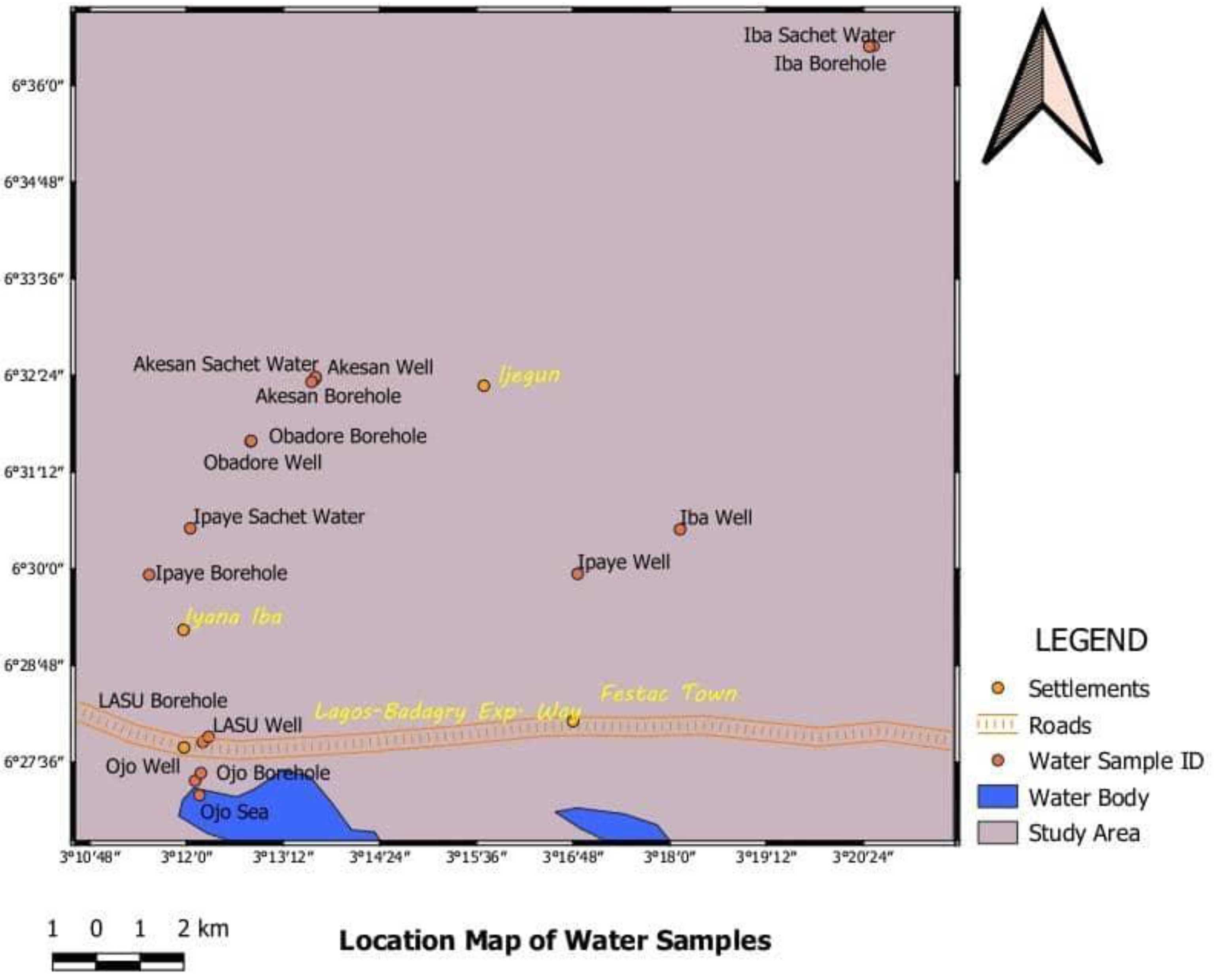
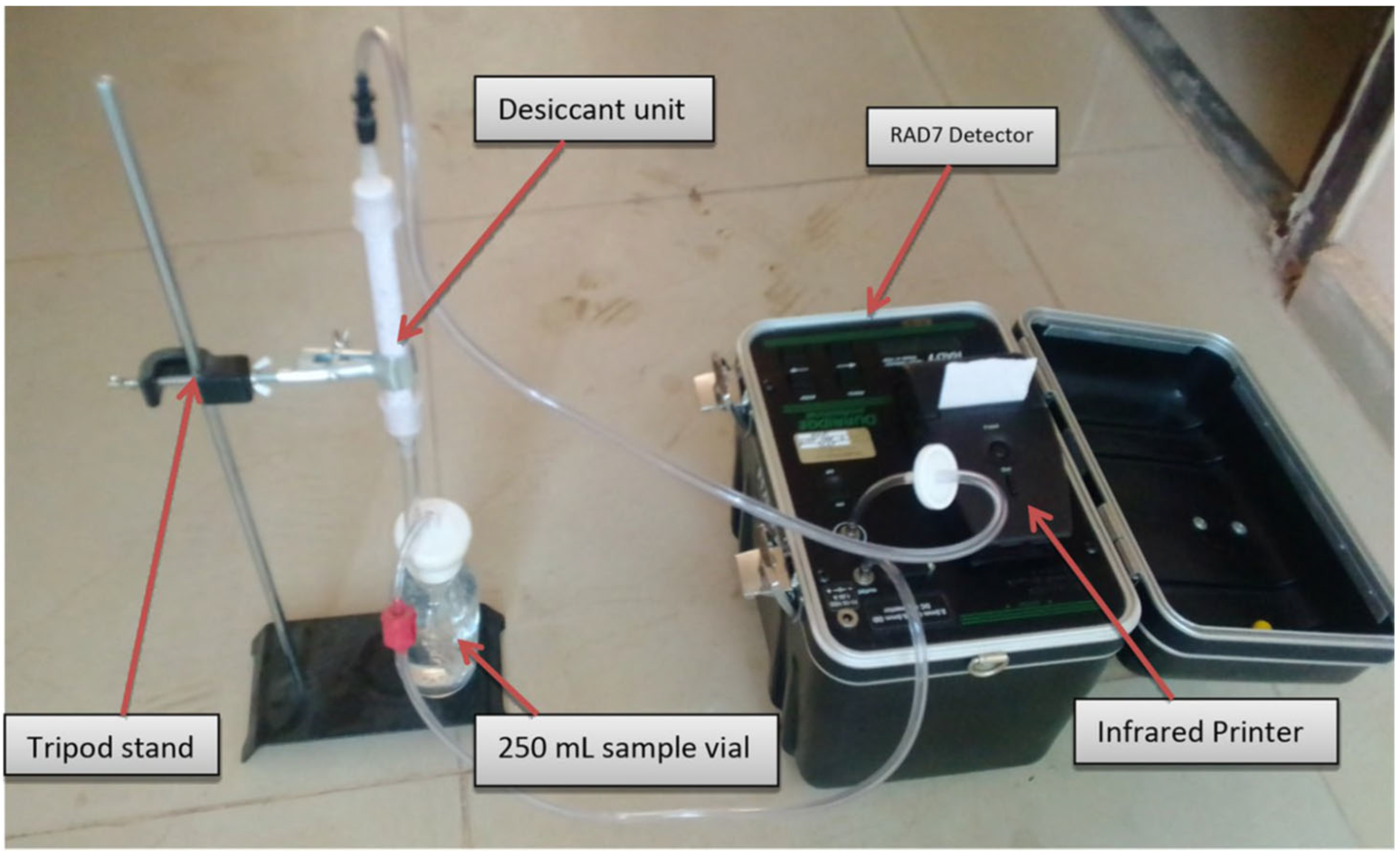
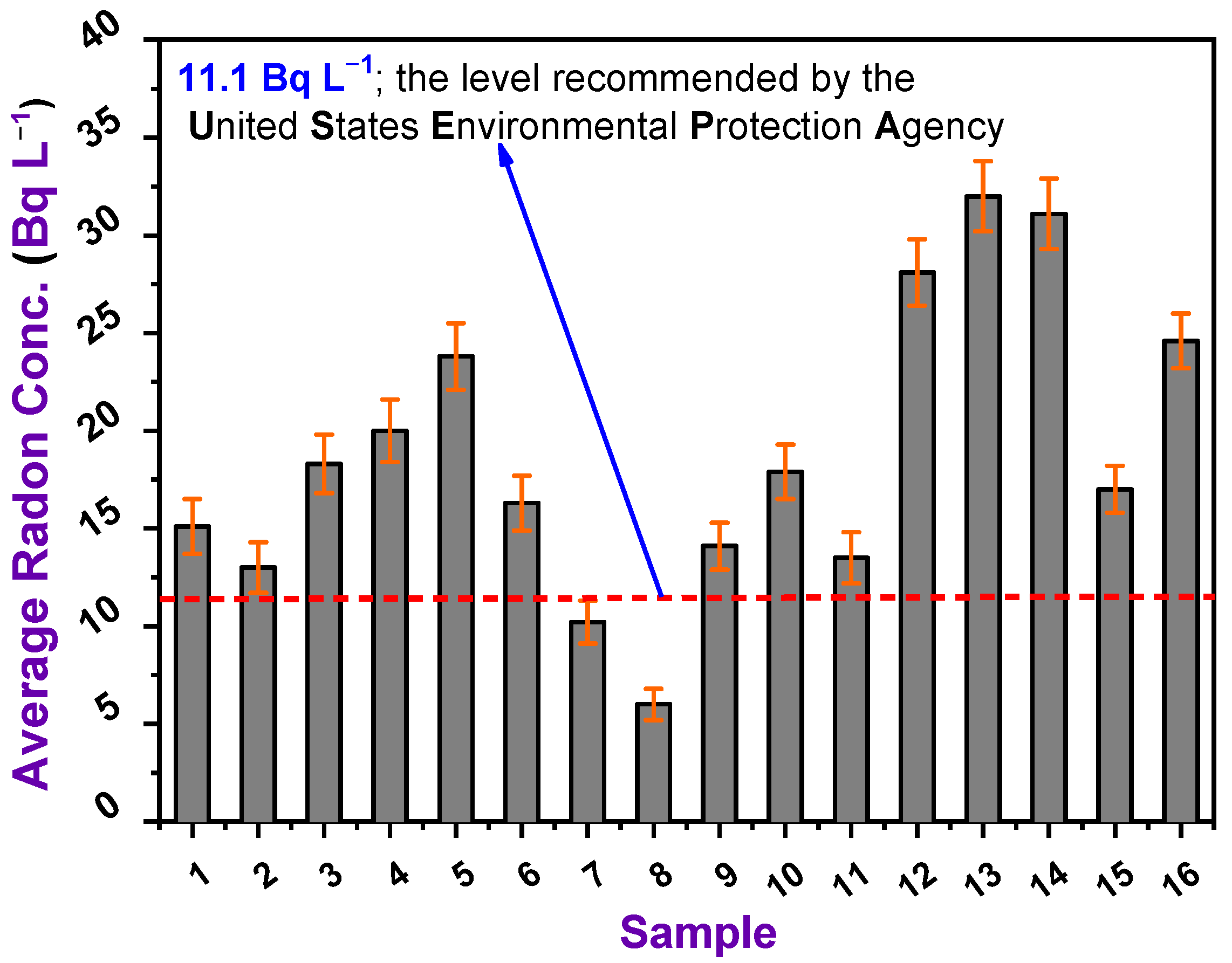

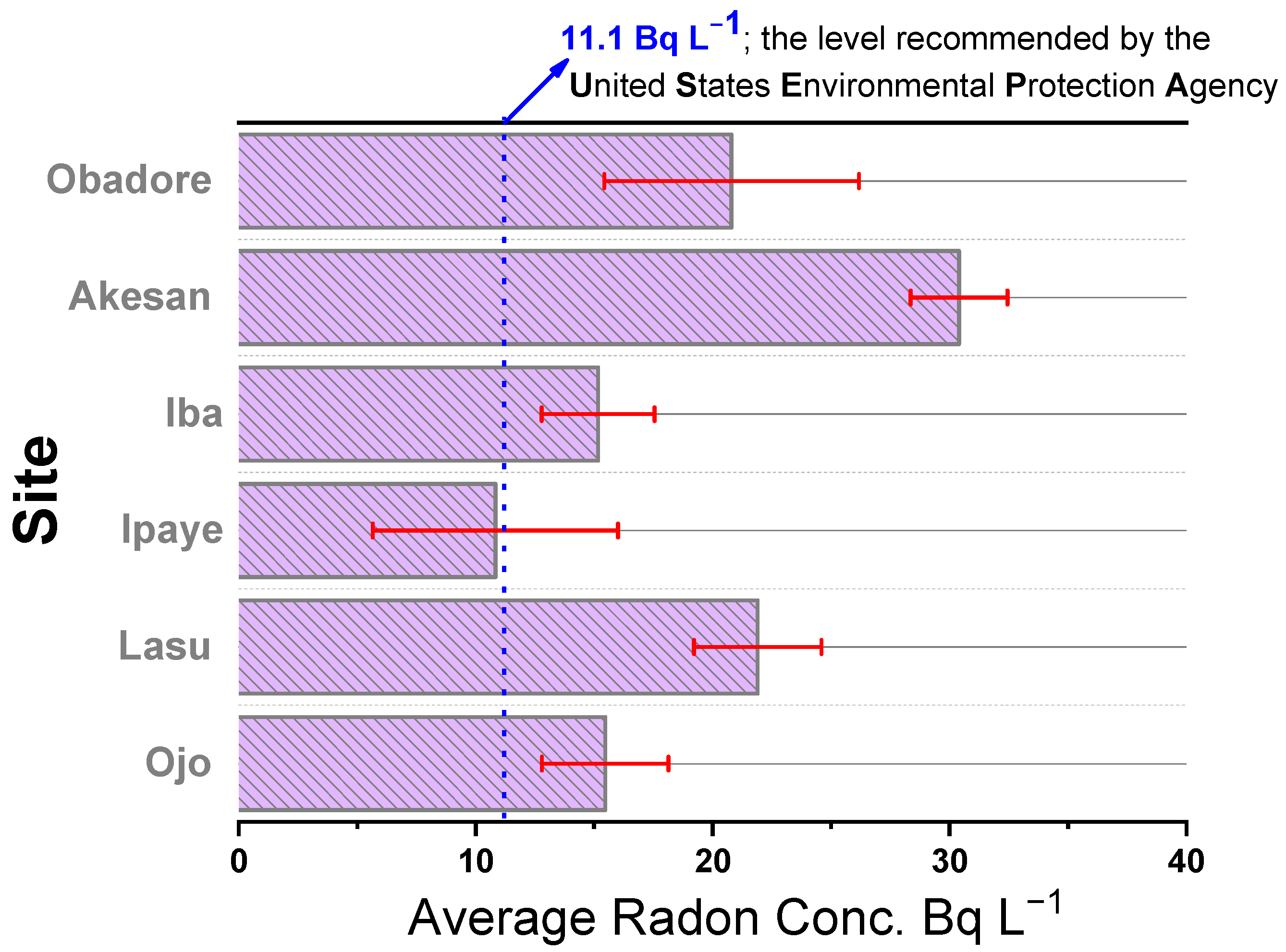
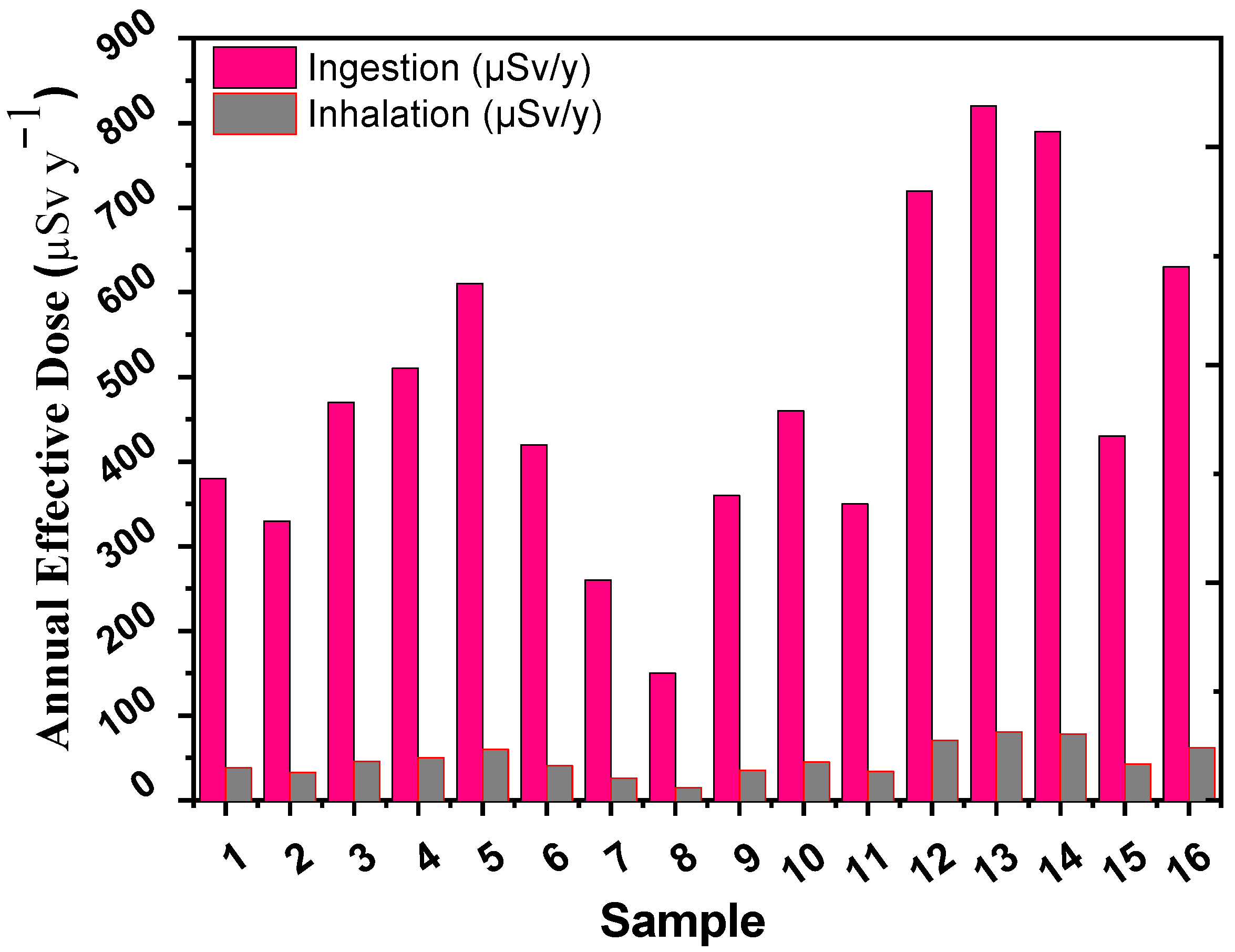
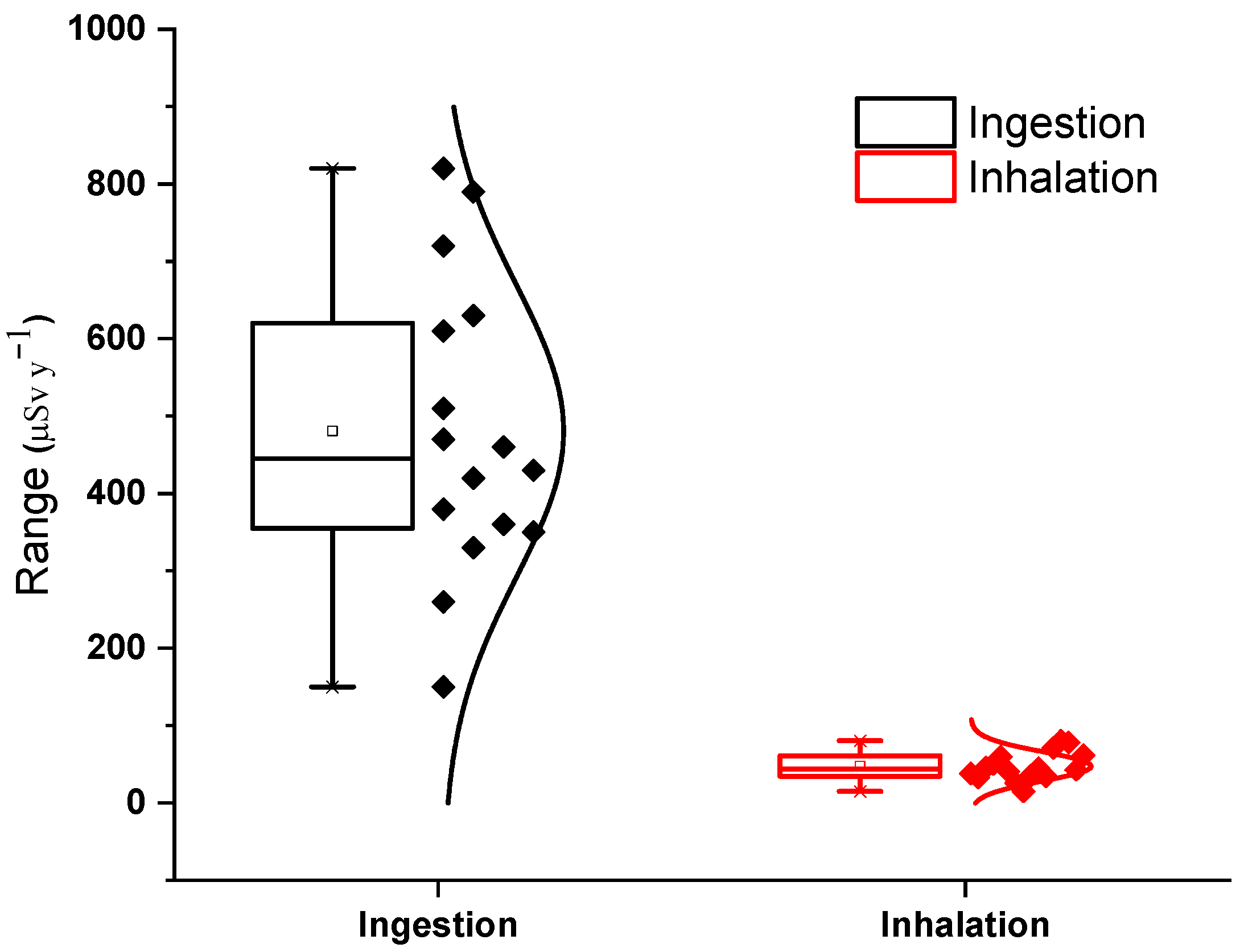
| Average Radon Conc. | Ingestion | Inhalation | ||
|---|---|---|---|---|
| Average Radon Conc. | Pearson Corr. | 1 | ||
| Ingestion | Pearson Corr. | 0.93618 | 1 | |
| Inhalation | Pearson Corr. | 0.99985 | 0.93416 | 1 |
Publisher’s Note: MDPI stays neutral with regard to jurisdictional claims in published maps and institutional affiliations. |
© 2022 by the authors. Licensee MDPI, Basel, Switzerland. This article is an open access article distributed under the terms and conditions of the Creative Commons Attribution (CC BY) license (https://creativecommons.org/licenses/by/4.0/).
Share and Cite
Mostafa, M.; Olaoye, M.A.; Ademola, A.K.; Jegede, O.A.; Saka, A.A.; Khalaf, H. Measurement of Radon Concentration in Water within Ojo Axis of Lagos State, Nigeria. Analytica 2022, 3, 325-334. https://doi.org/10.3390/analytica3030023
Mostafa M, Olaoye MA, Ademola AK, Jegede OA, Saka AA, Khalaf H. Measurement of Radon Concentration in Water within Ojo Axis of Lagos State, Nigeria. Analytica. 2022; 3(3):325-334. https://doi.org/10.3390/analytica3030023
Chicago/Turabian StyleMostafa, Mostafa, M. A. Olaoye, A. K. Ademola, O. A. Jegede, A. A. Saka, and Hyam Khalaf. 2022. "Measurement of Radon Concentration in Water within Ojo Axis of Lagos State, Nigeria" Analytica 3, no. 3: 325-334. https://doi.org/10.3390/analytica3030023







